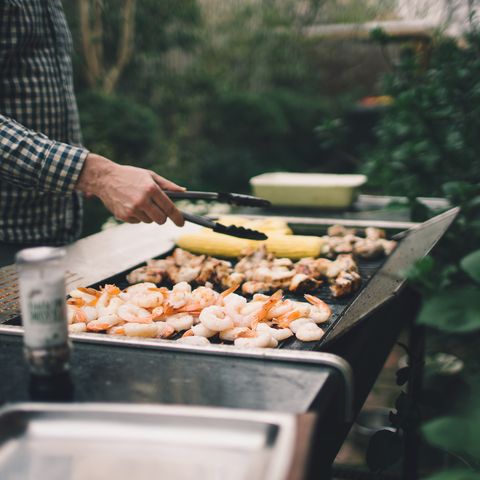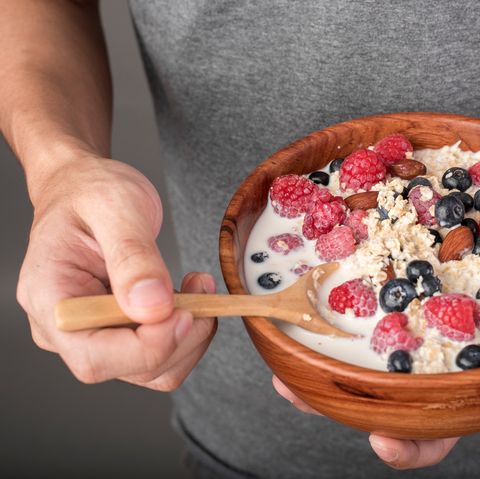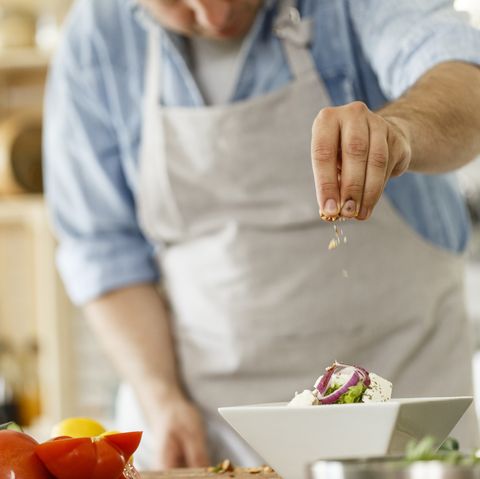4 Easy, Delicious Ways to Eat More Protein
You know protein is important for a healthful diet. It builds and maintains muscle. It helps you fill up faster and stay full longer. It is delicious.
Yet despite the fact that 55 percent of American households report that high protein is an important factor when buying groceries, they’re confused about what actually constitutes a high-protein food, according to 2018 Nielsen research.
More surprising findings from the Nielsen survey…
To clear things up, peanut butter has 8 grams of protein per two tablespoons, which is fine, but not amazing. Three ounces of cooked shrimp has 20 grams of protein and one cup of cottage cheese has 26 grams. And beef, chicken, and pork are all excellent sources of the nutrient.

Ippei Naoi
Protein shouldn’t be complicated, but often food manufacturers make it so by splashing “high-protein” across foods that really aren’t.
Do yourself a favor and simplify your approach to protein. Follow these four rules and you’ll eat all the protein you need in your day to reap the benefits—and stop doing all that head-scratching.
1. Wake up with protein powder.
Shakes. Shakes. Shakes. Shakes. Enough already. Blending protein powder with water or milk is great way to consume more protein throughout the day and it’s also a great way to get really sick of protein shakes.
Break up the boredom by thinking of your protein powder as an ingredient instead of just a supplement. Try stirring a scoop of chocolate protein powder into your morning bowl of oatmeal. Or blending a scoop of vanilla protein powder with milk and using that as your cereal milk.

Thanakorn Phanthura / EyeEm
Why breakfast? Even though most people think they eat enough of the nutrient at breakfast, it’s not quite enough to push them over the minimum of 25 grams of protein research shows can aid muscle growth and promote satiety. Two eggs and a piece of toast puts you at 18 grams. A scoop of protein powder usually has about 20 grams.
What kind of protein powder is best? That depends on your diet. If you eat animal products, opt for whey protein. If you don’t eat animal products, there are plenty of options available for you there too.
2. Clobber your salads with beans.
Beans, and their close culinary cousins legumes, are high in protein. A half cup of black beans has five grams of protein. The same amount of chickpeas has seven grams. Pintos, kidney, navy, soybeans—they all contain a good amount of protein.

Westend61
And they’re not just for chili. On salads, beans can add a pop of texture and a hit of creaminess. They also add a little color, too, if you’re the kind of person who likes to Instagram their salads.
3. Don’t forget your nuts.
Not only are nuts high in protein, they’re loaded with heart-healthy fats, fiber, and straight-up tastiness. You could snack them out of the jar or bag, but you can also use them as an ingredient in your cooking too.

fotostorm
Peanuts go well tossed into a stir-fry. Almonds are great finely chopped and sprinkled atop an olive-oil-based pasta dish. And walnuts are perfect atop oatmeal mixed with chocolate protein powder.
4. Expand your dinner rotation.
No man can live on bread alone. Same goes for grilled chicken breast. If you’re eating grilled chicken breast every night, yes, technically you’re going to eat the protein you need to build muscle and stay full.
But you’re also going to grow extremely bored and begin to not look forward to dinner. When that happens, try something new. There’s a world of protein out there. Salmon, wild-caught and farm-raised. Lamb chops. Pork chops. Tofu (yes, tofu!). Lobster. Cod. Duck. Bison. Tempeh. Scallops. And so! Much! More!
Beyond the unique flavors of each of these foods, there are also a host of nutrients special to each. So not only will you eat a more interesting diet, you’ll eat a more varied diet in terms of nutrients too.
Source: Read Full Article


